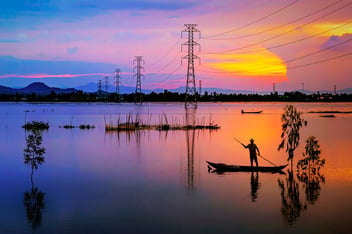Why COVID-19 presents an opportunity for water utilities to rethink energy
The COVID-19 pandemic has impacted energy markets around the world, with a decrease in consumption and the resulting decline in CO2 emissions offering energy and water utilities a chance to reset how they think and operate in pursuit of a greener future.
Ozwater’20 Online keynote speaker and Director of the International Energy Agency’s (IEA) Sustainability, Technology and Outlooks Directorate, Mechthild Wörsdörfer, said now is the time to focus on how to make sure CO2 emissions continue to reduce moving forward.
“We have to look at the actions taken by governments. We want to continue on the path of decreased CO2 emissions,” she said.
“There is no single pathway out of the COVID-19 crisis. We see that governments around the globe are reacting differently; they have been impacted differently.
“At IEA, we are creating a new world energy outlook. It will look at actions taken, which will create jobs, but also grind down CO2 emissions. Hopefully, this will be of interest for governments around the world.”
For more insights, don't miss week 2 of Ozwater'20 Online. To view the program, click here.
Wörsdörfer told Ozwater’20 Online attendees that while energy security has come under the spotlight in the crisis, the work of IEA has been focused on assisting governments and agencies with continuing the trend of CO2 reduction that has occurred since the crisis began.
“Energy security, including oil, gas, electricity security, remains a cornerstone of our economies, especially during these times. Without electricity, our systems, our hospitals, our suppliers wouldn't be able to work,” she said.
“We are now coming slightly out of the initial impacts [of the crisis], but clean energy transitions are coming up in the middle of economic recovery. Our role here in the IEA is focused on helping governments navigate through these challenges in order to build a secure and sustainable energy system.”
A shock to the system
Wörsdörfer said the world hasn’t seen a decline in energy demand of this magnitude since World War II, with the annual energy demand expected to drop by 6% in 2020, a turn the last five years of demand growth.
“We haven't seen such a shock, such an impact on the energy system. This is obviously due to the lockdown in more than 180 countries … For Australia and New Zealand, that drop in energy demand is expected to be 6%, similar to the rest of the world,” she said.
“This has an impact on all fuel. If we look at the dominant fuels worldwide – coal, natural gas and oil – there is a drop by 9% average across the year, which means that we are returning to oil consumption of 2012 levels.
“The global electricity demand is on track to fall by 5% in 2020. Also, this has been the largest decline we have seen since the great depression.”
All of these declines in consumption have resulted in a decline in CO2 emissions. Wörsdörfer said that although the decline is likely to be temporary, it’s crucial to ensure structural changes are considered when leading into COVID-19 recovery.
“According to our estimates, there has been an impact on the global CO2 emissions. We expect almost an 8% decline. This is the strongest decline ever in the history of CO2 emissions,” she said.
“But we should be well aware that this drop in CO2 emissions is temporary. It's due to the lockdown. It's due to drop in energy demand, and it's not structural.
“In order to continue the path to the Paris Agreement, we need to do much more structural, and that's part of the debate right now, everywhere on the recovery. We need to make sure that the recovery package, that there are also structural changes in the energy sector, but also in many other sectors to keep that in line.”
Greener futures
WIth water and energy so closely connected, Wörsdörfer said the increasing demand for water and subsequent energy consumption placed the water sector front and centre of the debate regarding how to transition to a greener future.
“There is a strong nexus between water and energy. If we look at the energy sector's water consumption, it will be rising,” she said.
“This is underpinned by an increase in biofuel production, rise in nuclear power generation, and a shift to advanced cooling technologies in thermal power plants that withdraw less water, but consume more.
“For Australia and New Zealand, the energy sector's water consumption is likely to rise more slowly, but increasing by less than 20% in our pre-coronavirus analysis. Our need for water also gets more energy intensive by 2040.”
In Australia, Wörsdörfer recommends continuing to explore and promote more sustainable energy sources in order to ensure the nation stays on track to meet its commitments to the Sustainable Development Goals.
“In Australia, there's a lot of investment in a new strategy on hydrogen,” she said.
“Hydrogen can be a solution. All these technologies [and] clean energy investment need to get a step deeper in order to be on the right track for the clean energy transition.”
To learn more about Ozwater’20 online and to register, click here.

